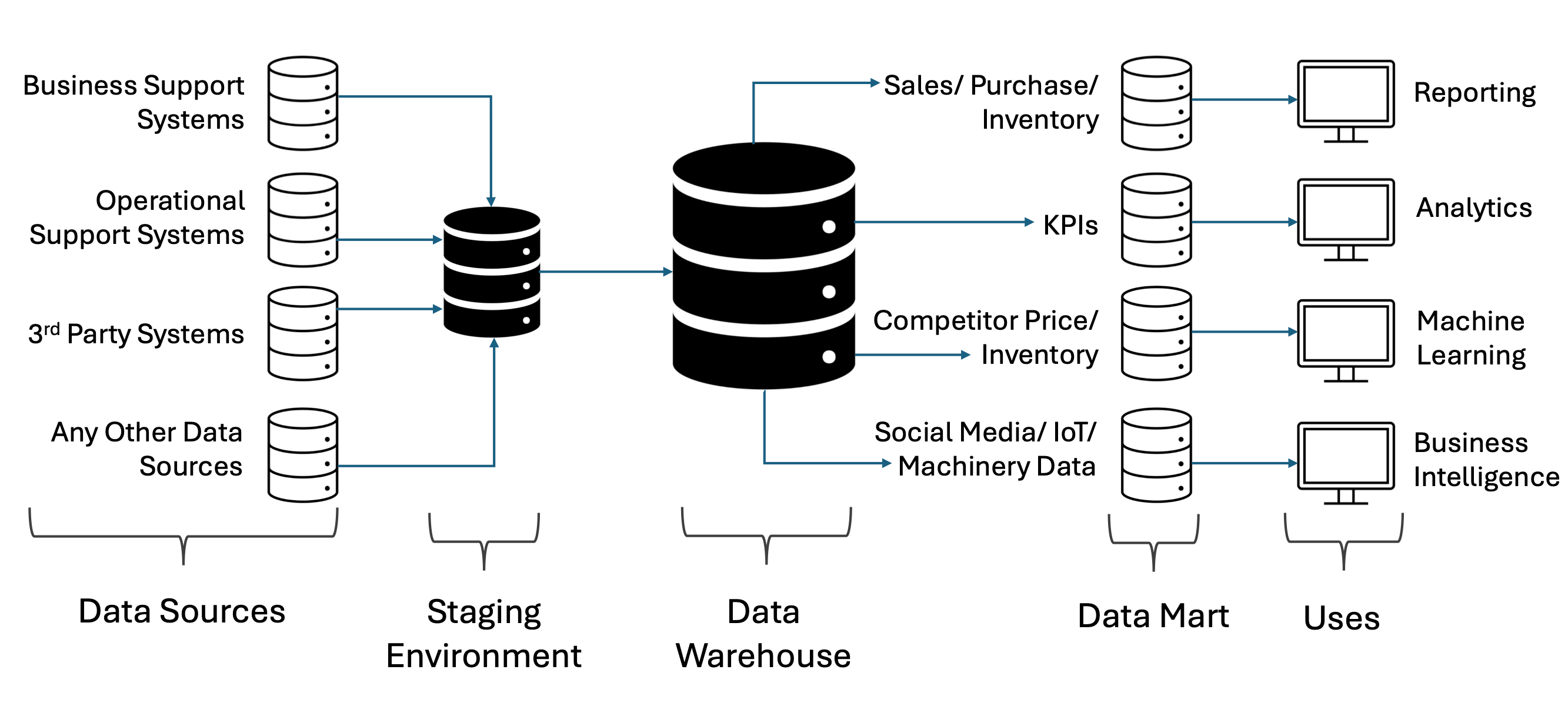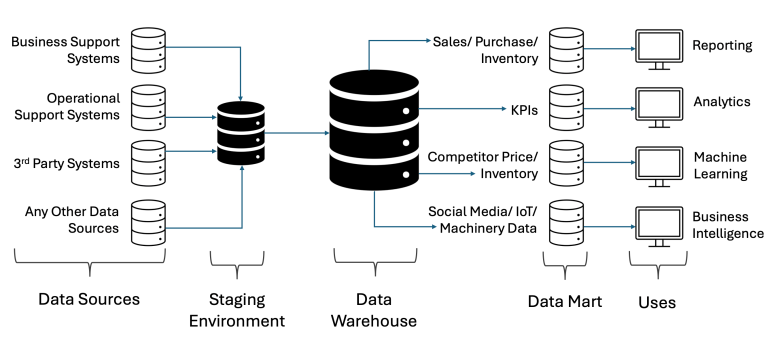The Difference Between Data Warehouses and Data Marts
- 27 January 2024
Table of contents
What Is A Data Warehouse?
A data warehouse is a large, centralized repository that stores vast amounts of structured, semi-structured, and unstructured data from multiple sources. It is designed to support business intelligence (BI), reporting, and data analysis. Data warehouses typically aggregate data from transactional systems, operational databases, and external sources.
What Is A Data Mart?
A data mart is a smaller, more focused version of a data warehouse that is specific to a particular business line, department, or function (e.g., marketing, finance). It stores a subset of the data that is more relevant to a specific business unit.

When Do You Need Data Warehouse?
- Centralized storage of data from multiple sources.
- Enables complex queries and large-scale reporting.
- Supports data-driven decision-making and strategic planning.
- Facilitates historical data analysis and predictive analytics.
When Do You Need Data Marts?
- Allows for faster access to relevant data for specific departments.
- Simplifies data analysis for targeted, departmental needs.
- Reduces the load on the larger data warehouse.
Is a Data Warehouse Simply A Database?
No, a data warehouse is not just a regular database. While both store data, there is a significant difference between data warehouses and traditional databases. A data warehouse is specifically designed for analytical and reporting purposes, optimized for reading large volumes of data and executing complex queries efficiently. In contrast, transactional databases are built for day-to-day operations, focusing on CRUD (Create, Read, Update, Delete) operations to handle transactional workloads.
Understanding the difference between a data warehouse and a data mart is also key. While a data warehouse consolidates data from across the entire organization for comprehensive analysis, a data mart is a smaller, specialized subset of this data, tailored to meet the needs of specific departments or business units.
Data marts offer a focused, department-specific view of data, allowing teams to quickly access and analyze the information most relevant to their needs.
Ralph Kimball
Do you first have data mart or data warehouse?
Typically, a data warehouse is established first, consolidating all of an organization’s data into a single source of truth. This central repository allows for comprehensive data analysis across the enterprise. In contrast, data marts are created as smaller, domain-specific subsets of the warehouse data, designed to meet the specific needs of individual departments.
The key data warehouse and data mart difference lies in their scope: while the data warehouse provides a holistic view of the organization’s data, data marts focus on targeted, departmental insights. In some cases, organizations may initially build data marts to address immediate departmental needs, later integrating them into a more comprehensive data warehouse architecture.
How are data processed through data warehouse?
Data is typically loaded into a data warehouse through an ETL (Extract, Transform, Load) or ELT (Extract, Load, Transform) process:
Extract
Data is extracted from various sources like databases, applications, and external sources.
Transform
The extracted data is cleaned, formatted, and transformed into a standardized format.
Load
The cleaned data is loaded into the data warehouse for analysis and reporting.
Fun Fact!
While both data warehouses and data marts store data, a data warehouse is like a giant supermarket with everything you need, while a data mart is more like a specialty store focused on a specific category! Data warehouses hold vast amounts of enterprise-wide data, whereas data marts cater to specific departments or functions for quicker and easier access.
What are the key considerations before building a data mart and/or warehouse in an e-commerce environment?
Key questions include:
- What business goals does the data warehouse or mart need to support?
- What data sources need to be integrated (e.g., sales, customer, marketing)?
- What kind of reports and analytics will users require?
- How much historical data will need to be stored?
- What level of security and access control is necessary?
- How will data be updated in real-time or near-real-time?
- What are the performance and scalability requirements?
What are the key strategy in preparing your data for your data mart/ data warehouse project?
The data preparation strategy includes the following:
Clean
Remove errors, inconsistencies, and duplicates from data.
Correct
Validate and ensure the accuracy of data values.
Consolidate
Integrate data from various sources into a unified format.
Contextualize
Add context or metadata to the data for better understanding and usability.
Classify
Organize data into meaningful categories for easier access and analysis.
How much time does it require to build a data mart or data warehouse?
Building a data warehouse or data mart can take anywhere from months to years, depending on the project’s scope, complexity, and data volume. The difference between a data warehouse and a data mart plays a significant role in determining the time and effort required. A data warehouse typically involves integrating multiple data sources across the organization, requiring extensive data transformations, quality checks, and scalability considerations. On the other hand, a data mart focuses on specific, department-level data, making it faster to implement but narrower in scope.
Factors influencing the timeline include:
- The number of data sources to integrate.
- The complexity of data transformations.
- Data quality and cleansing requirements.
- Infrastructure setup and configuration.
- Scalability and performance tuning.
- Testing, validation, and user training.
A data warehouse is the backbone of business intelligence, providing a centralized repository for large-scale data analysis and driving strategic decision-making.
Bill Inmon
Who will benefit from using data mart and/or warehouse?
Executives & Decision-Makers
They benefit from high-level dashboards, reporting, and insights for strategic decisions.
Business Analysts & Data Scientists
They gain access to consolidated data for in-depth analysis and modeling.
Marketing, Finance, and Operations Teams:
Data marts enable quick access to specific datasets tailored to their needs, making their work more efficient.
IT Departments
A centralized data warehouse reduces the burden of managing multiple, disconnected data systems, improving data governance and security.
Primalcom Advantage
Primalcom’s data warehouse solutions, spanning platforms like AWS, Snowflake, Apache, and PostgreSQL, empower organizations to efficiently manage and analyze massive datasets. By integrating advanced data warehouse and data mart architectures, businesses can streamline their data processes, enabling faster, data-driven decisions and enhancing overall operational performance.
Table of contents
What Is A Data Warehouse?
A data warehouse is a large, centralized repository that stores vast amounts of structured, semi-structured, and unstructured data from multiple sources. It is designed to support business intelligence (BI), reporting, and data analysis. Data warehouses typically aggregate data from transactional systems, operational databases, and external sources.
What Is A Data Mart?
A data mart is a smaller, more focused version of a data warehouse that is specific to a particular business line, department, or function (e.g., marketing, finance). It stores a subset of the data that is more relevant to a specific business unit.

When Do You Need Data Warehouse?
- Centralized storage of data from multiple sources.
- Enables complex queries and large-scale reporting.
- Supports data-driven decision-making and strategic planning.
- Facilitates historical data analysis and predictive analytics.
When Do You Need Data Marts?
- Allows for faster access to relevant data for specific departments.
- Simplifies data analysis for targeted, departmental needs.
- Reduces the load on the larger data warehouse.
Is a Data Warehouse Simply A Database?
No, a data warehouse is not just a regular database. While both store data, there is a significant difference between data warehouses and traditional databases. A data warehouse is specifically designed for analytical and reporting purposes, optimized for reading large volumes of data and executing complex queries efficiently. In contrast, transactional databases are built for day-to-day operations, focusing on CRUD (Create, Read, Update, Delete) operations to handle transactional workloads.
Understanding the difference between a data warehouse and a data mart is also key. While a data warehouse consolidates data from across the entire organization for comprehensive analysis, a data mart is a smaller, specialized subset of this data, tailored to meet the needs of specific departments or business units.
Do you first have data mart or data warehouse?
Typically, a data warehouse is established first, consolidating all of an organization’s data into a single source of truth. This central repository allows for comprehensive data analysis across the enterprise. In contrast, data marts are created as smaller, domain-specific subsets of the warehouse data, designed to meet the specific needs of individual departments.
The key data warehouse and data mart difference lies in their scope: while the data warehouse provides a holistic view of the organization’s data, data marts focus on targeted, departmental insights. In some cases, organizations may initially build data marts to address immediate departmental needs, later integrating them into a more comprehensive data warehouse architecture.
How are data processed through data warehouse?
Data is typically loaded into a data warehouse through an ETL (Extract, Transform, Load) or ELT (Extract, Load, Transform) process:
- Extract: Data is extracted from various sources like databases, applications, and external sources.
- Transform: The extracted data is cleaned, formatted, and transformed into a standardized format.
- Load: The cleaned data is loaded into the data warehouse for analysis and reporting.
What are the key considerations before building a data mart and/or warehouse in an e-commerce environment?
Key questions include:
- What business goals does the data warehouse or mart need to support?
- What data sources need to be integrated (e.g., sales, customer, marketing)?
- What kind of reports and analytics will users require?
- How much historical data will need to be stored?
- What level of security and access control is necessary?
- How will data be updated in real-time or near-real-time?
- What are the performance and scalability requirements?
What are the key strategy in preparing your data for your data mart/ data warehouse project?
The data preparation strategy includes the following:
- Clean: Remove errors, inconsistencies, and duplicates from data.
- Correct: Validate and ensure the accuracy of data values.
- Consolidate: Integrate data from various sources into a unified format.
- Contextualize: Add context or metadata to the data for better understanding and usability.
- Classify: Organize data into meaningful categories for easier access and analysis.
How much time does it require to build a data mart or data warehouse?
Building a data warehouse or data mart can take anywhere from months to years, depending on the project’s scope, complexity, and data volume. The difference between a data warehouse and a data mart plays a significant role in determining the time and effort required. A data warehouse typically involves integrating multiple data sources across the organization, requiring extensive data transformations, quality checks, and scalability considerations. On the other hand, a data mart focuses on specific, department-level data, making it faster to implement but narrower in scope.
Factors influencing the timeline include:
- The number of data sources to integrate.
- The complexity of data transformations.
- Data quality and cleansing requirements.
- Infrastructure setup and configuration.
- Scalability and performance tuning.
- Testing, validation, and user training.
Who will benefit from using data mart and/or warehouse?
- Executives & Decision-Makers: They benefit from high-level dashboards, reporting, and insights for strategic decisions.
- Business Analysts & Data Scientists: They gain access to consolidated data for in-depth analysis and modeling.
- Marketing, Finance, and Operations Teams: Data marts enable quick access to specific datasets tailored to their needs, making their work more efficient.
- IT Departments: A centralized data warehouse reduces the burden of managing multiple, disconnected data systems, improving data governance and security.
Primalcom Advantage
Primalcom’s data warehouse solutions, spanning platforms like AWS, Snowflake, Apache, and PostgreSQL, empower organizations to efficiently manage and analyze massive datasets. By integrating advanced data warehouse and data mart architectures, businesses can streamline their data processes, enabling faster, data-driven decisions and enhancing overall operational performance.